
Reforestation is the natural or intentional restocking of existing forests and woodlands (forestation) that have been depleted, usually through deforestation but also after clearcutting. Two important purposes of reforestation programs are for harvesting of wood or for climate change mitigation purposes.

Logging is the process of cutting, processing, and moving trees to a location for transport. It may include skidding, on-site processing, and loading of trees or logs onto trucks or skeleton cars. In forestry, the term logging is sometimes used narrowly to describe the logistics of moving wood from the stump to somewhere outside the forest, usually a sawmill or a lumber yard. In common usage, however, the term may cover a range of forestry or silviculture activities.
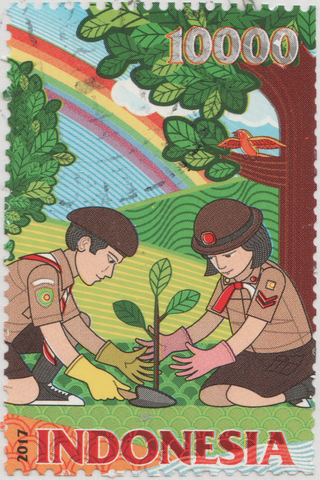
Environmental issues in Indonesia are associated with the country's high population density and rapid industrialisation, and they are often given a lower priority due to high poverty levels, and an under-resourced governance.
Environmental issues in Pakistan include air pollution, water pollution, noise pollution, climate change, pesticide misuse, soil erosion, natural disasters, desertification and flooding. According to the 2020 edition of the environmental performance index (EPI) ranking released by Yale Center for Environmental Law & Policy, Pakistan ranks 142 with an EPI score of 33.1, an increase of 6.1 over a 10-year period. It ranked 180 in terms of air quality. The climatic changes and global warming are the most alarming issues risking millions of lives across the country. The major reasons of these environmental issues are carbon emissions, population explosion, and deforestation.

Environmental issues in Nepal include a number of issues, such as deforestation, climate change, energy and species conservation. Many of these issues have been precipitated by rapid industrialization without major environmental regulation.
The Lower Guinean forests also known as the Lower Guinean-Congolian forests, are a region of coastal tropical moist broadleaf forest in West Africa, extending along the eastern coast of the Gulf of Guinea from eastern Benin through Nigeria and Cameroon.

Deforestation in Cambodia has increased in recent years. Cambodia is one of the world's most forest endowed countries, that was not historically widely deforested. However, massive deforestation for economic development threatens its forests and ecosystems. As of 2015, the country has one of the highest rates of deforestation in the world.
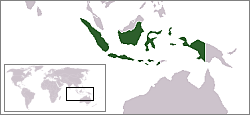
The environment of Indonesia consists of 17,508 islands scattered over both sides of the equator. Indonesia's size, tropical climate, and archipelagic geography, support the world's second highest level of biodiversity after Brazil.
Environmental issues in Brazil include deforestation, illegal wildlife trade, illegal poaching, air, land degradation, and water pollution caused by mining activities, wetland degradation, pesticide use and severe oil spills, among others. As the home to approximately 13% of all known species, Brazil has one of the most diverse collections of flora and fauna on the planet. Impacts from agriculture and industrialization in the country threaten this biodiversity.
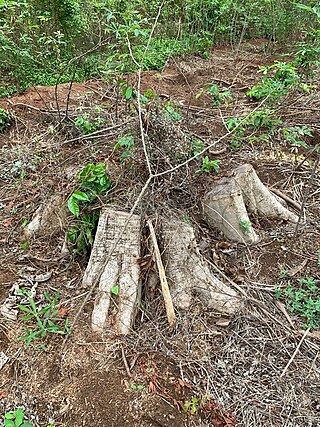
Deforestation in Nigeria refers to the extensive and rapid clearing of forests within the borders of Nigeria. This environmental issue has significant impacts on both local and global scales.

Deforestation is a major threat to biodiversity and ecosystems in Costa Rica. The country has a rich biodiversity with some 12,000 species of plants, 1,239 species of butterflies, 838 species of birds, 440 species of reptiles and amphibians, and 232 species of mammals, which have been under threat from the effects of deforestation. Agricultural development, cattle ranching, and logging have caused major deforestation as more land is cleared for these activities. Despite government efforts to mitigate deforestation, it continues to cause harm to the environment of Costa Rica by impacting flooding, soil erosion, desertification, and loss of biodiversity.

Rates and causes of deforestation vary from region to region around the world. In 2009, two-thirds of the world's forests were located in just 10 countries: Russia, Brazil, Canada, the United States, China, Australia, the Democratic Republic of the Congo, Indonesia, India, and Peru.

Central American countries have experienced cycles of deforestation and reforestation since the decline of Maya civilization, influenced by many factors such as population growth, agriculture, narcotic distribution and illegal practices. From 2001 to 2010, 5,376 square kilometres (2,076 sq mi) of forest were lost in the region. In 2010 Belize had 63% of remaining forest cover, Costa Rica 46%, Panama 45%, Honduras 41%, Guatemala 37%, Nicaragua 29%, and El Salvador 21%. Most of the loss occurred in the moist forest biome, with 12,201 square kilometers. Woody vegetation loss was partially set off by a plus in the coniferous forest biome with 4,730 km2, and at 2,054 km2. Mangroves and deserts contributed only 1% to the loss in forest vegetation. The bulk of the deforestation was located at the Caribbean slopes of Nicaragua with a minus of 8,574 square kilometers of forest lost in the period from 2001 to 2010. The most significant regrowth of 3,050 km2 of forest was seen in the coniferous woody vegetation of Honduras.
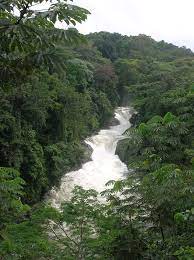
Oba Hills Forest Reserve is a reserve in Iwo, Osun State, Nigeria, that covers about 52 square kilometres (20 sq mi) of hilly terrain with deep gorges. Oba Hill Forest Reserve is a small enclave encompassing three hills with a wide valley running in between. A large teak plantation is on its western side, covering about 12% of its total area beyond the hills. Only coppices are left on the over-exploited plantation. According to a UICN report from 2003, about 12% of the reserve had been planted with teak. Some chimpanzee sightings had been reported, and in 1999, a dead chimpanzee was offered for sale in a local market. A 2009 report said that almost all of the reserve had been converted to plantations and farms, with only two gullies remaining forest-covered. It is now believed that chimpanzees are nearly extinct in the reserve.
Akure Forest Reserve is a protected area in southwest Nigeria, covering 66 km2 (25 sq mi). The Akure Forest Reserve, established in 1948 and spanning approximately 32 hectares. It was created with the primary aim of safeguarding the genetic diversity of the forest ecosystem. About 11.73% is estimated to be cleared for cocoa farming and other food crops. Aponmu and Owena Yoruba speaking communities owned the forest, though, there are also minor settlements surrounding the forest. They include Ipogun, Kajola/ Aponmu, Kajola, Ago Petesi, Akika Camp, Owena Town, Ibutitan/Ilaro Camp, Elemo Igbara Oke Camp and Owena Water new Dam.

Among Bhutan's most pressing environmental issues are traditional firewood collection, crop and flock protection, and waste disposal, as well as modern concerns such as industrial pollution, wildlife conservation, and climate change that threaten Bhutan's population and biodiversity. Land and water use have also become matters of environmental concern in both rural and urban settings. In addition to these general issues, others such as landfill availability and air and noise pollution are particularly prevalent in relatively urbanized and industrialized areas of Bhutan. In many cases, the least financially and politically empowered find themselves the most affected by environmental issues.
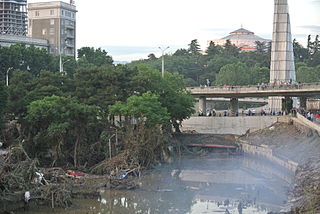
Situated in the South Caucasus Region bordered by the Black Sea to the West, the Russian Federation to the North, Azerbaijan to the East, Turkey to the Southwest, and Armenia to the South, Georgia is a small country supplied with profitable natural resources, heavenly scenes, copious water assets, rich living spaces, and ecosystems that are of local and worldwide significance.

The biogeographic regionalization of Earth's terrestrial biodiversity, known as Terrestrial Ecoregions of the World (TEOW), is made up of 867 ecoregions that are divided into 14 biomes. In addition to offering a comprehensive map of terrestrial biodiversity, TEOW also provides a global species database for ecological analyses and priority setting, a logical biogeographic framework for large-scale conservation strategies, a map for enhancing biogeographic literacy, and a foundation for the Global 200.

Fruit production is a major driver of deforestation around the world. In tropical countries, forests are often cleared to plant fruit trees, such as bananas, pineapples, and mangos. This deforestation is having a number of negative environmental impacts, including biodiversity loss, ecosystem disruption, and land degradation.

















